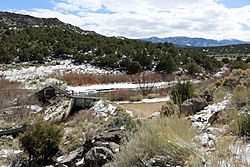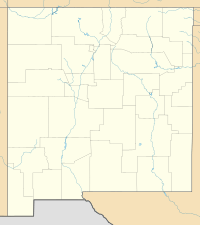Costilla Creek facts for kids
Quick facts for kids Costilla Creek |
|
|---|---|

The diversion dam on the creek, just above Costilla, where the Acequia Madre begins.
|
|
|
Location of the creek's mouth in Taos County, New Mexico
|
|
| Other name(s) | Río Costilla, Costilla River, Costilla Creek Number One, Río de Costilla |
| Country | United States |
| States | Colorado, New Mexico |
| Counties | Costilla County, Colorado, Taos County, New Mexico |
| Physical characteristics | |
| Main source | Confluence of West Fork Costilla Creek and East Fork Costilla Creek Costilla County, Colorado 36°59′45″N 105°15′04″W / 36.99583°N 105.25111°W |
| River mouth | Rio Grande Taos County, New Mexico 7,369 feet (2,246 meters) 36°58′51″N 105°43′03″W / 36.98083°N 105.71750°W |
Costilla Creek is a cool stream that flows through both Colorado and New Mexico. It's a smaller river that eventually joins the much larger Rio Grande.
Where Does Costilla Creek Flow?
Costilla Creek starts high up in the Sangre de Cristo Mountains. It begins in southern Colorado where two smaller streams, East Fork Costilla Creek and West Fork Costilla Creek, meet.
From there, the creek flows south and crosses into New Mexico. Here, its waters are held back by the Costilla Reservoir. This reservoir is privately owned.
After the reservoir, the creek generally flows southwest. It meets another stream called Comanche Creek. Costilla Creek then curves northwest, flowing near New Mexico State Road 196.
The creek continues northwest, following State Road 196. It passes through the small town of Amalia. As it leaves the mountains, it flows through a special dam. This dam helps create the Acequia Madre, an irrigation ditch that carries water to farms. Just after this, the creek flows through the town of Costilla. It then enters a wide, flat area called the Taos Plateau volcanic field.
Costilla Creek then flows north from Costilla and re-enters Colorado near Garcia. It makes a big curve to the west. Then it flows south, just west of Jaroso, Colorado. Finally, it crosses back into New Mexico one last time. Soon after, the creek turns southwest and empties into the Rio Grande. Its mouth is in a deep gorge near Ute Mountain.
What Fish Live in Costilla Creek?
Costilla Creek is a popular spot for people who love to fish! You can find different types of trout here, including:
The Rio Costilla is regularly stocked with trout from spring to fall. This means new fish are added to the creek so there are always plenty for anglers.
The New Mexico Department of Game and Fish is working on an important project. It's called the "Restoration of Rio Grande Cutthroat Trout and the Native Fish Community to the Upper Rio Costilla Watershed." This project started in March 2021 and was expected to finish by fall 2021.
The main goal of this project is to help native fish, especially the Rio Grande cutthroat trout. They are removing fish that are not native to the area, like some rainbow trout and suckers. By doing this, they hope to:
- Provide great fishing opportunities for native trout.
- Help the Rio Grande cutthroat trout spread to more areas.
- Make sure these native fish are less likely to become threatened or endangered. This means protecting them from disappearing.


